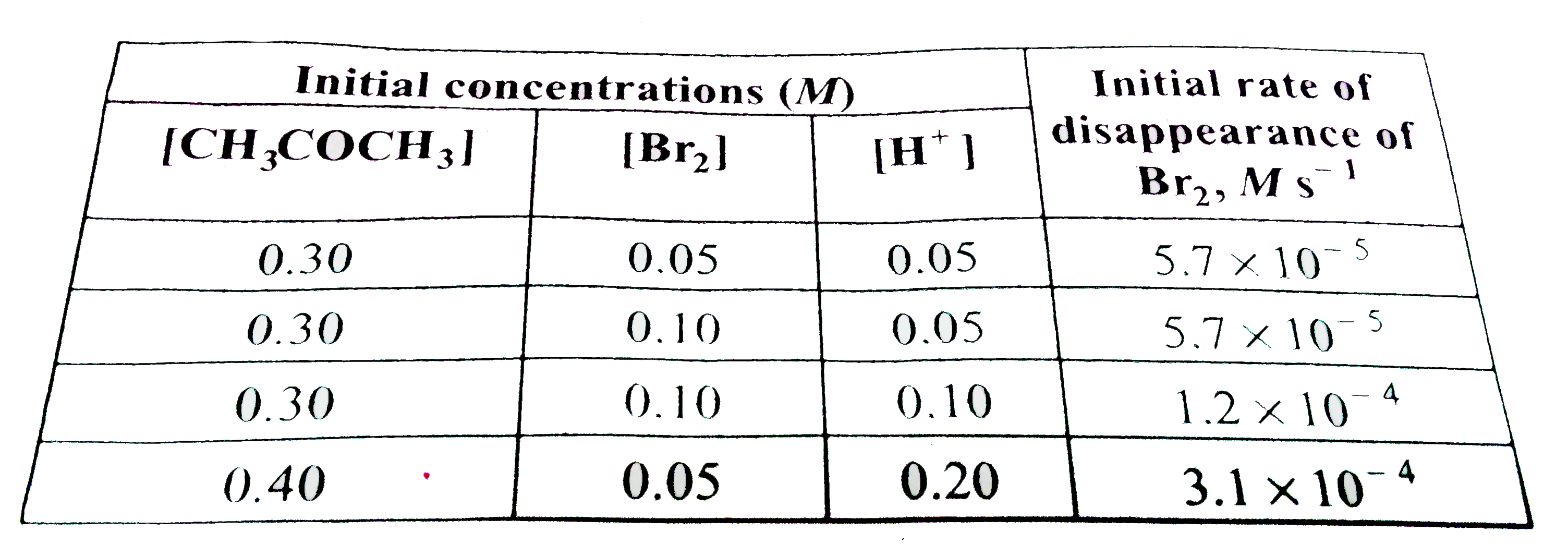The bromination of acetone that occurs in acid solution is represented by this equation.
These kinetic data were obtained for given reaction concentrations.
Based on these data, the rate equation is
Rate=
Rate=
Rate=
Rate=
The correct Answer is:C
From the first two experiments, it is clear that when concentration of is doubled, the initial rate of disappearance of remains unaltered. So, order of reaction with respect to is zero. The probable rate law for the reaction will be :
Topper's Solved these Questions
- CHEMICAL KINETICSBOOK - MTG GUIDECHAPTER - CHEMICAL KINETICSEXERCISE - CHECK YOUR NEET VITALS
25 Videos
- CHEMICAL KINETICSBOOK - MTG GUIDECHAPTER - CHEMICAL KINETICSEXERCISE - AIPMT/NEET (MCQs)
22 Videos
- CHEMICAL KINETICSBOOK - MTG GUIDECHAPTER - CHEMICAL KINETICSEXERCISE - AIPMT/NEET (MCQs)
22 Videos
- BIOMOLECULESBOOK - MTG GUIDECHAPTER - BIOMOLECULESEXERCISE - AIPMT/NEET (MCQS)
19 Videos
- CHEMISTRY IN EVERYDAY LIFE BOOK - MTG GUIDECHAPTER - CHEMISTRY IN EVERYDAY LIFE EXERCISE - AIPMT/NEET
9 Videos
Similar Questions
The bromination of acetone that occurs in acid solution is represented by this equation.
CH3COCH3(aq)+Br2(aq)→
CH3COCH2Br(aq)+H+(aq)+Br(aq)
These kinetic data were obtained for given reaction concentrations.
Initial concentration, M
[CH2COCH3][Br2][H+](Initail rate) (disappearance of Br2)0.300.050.055.7×10−50.300.100.055.7×10−50.300.100.101.2×10−40.400.50.203.1×10−4
View SolutionThe bromination of acetone that occurs in acid solution is represented by
CH3COCH3(aq.)+Br2(aq.)→CH3COCH2Br(aq.)+H+(aq.)+Br−(aq.)
These kinetic data were obtained for given reaction concentration
Initial concentration
Initial concentrationInitial rate ofdisappearance[CH3COCH3][Br2][H+]of Br20.300.050.055.0×10−50.300.100.55.0×10−50.300.100.101.0×10−40.900.050.103.0×10−4
Based on these data, order of reaction will be -
View Solution
Knowledge Check
The bromination of acetone that occurs in acid solution is represented by this equation.
CH3COCH3(aq)+Br2(aq)→
CH3COCH2Br(aq)+H+(aq)+Br(aq)
These kinetic data were obtained for given reaction concentrations.
Initial concentration, M
[CH2COCH3][Br2][H+](Initail rate) (disappearance of Br2)0.300.050.051.5×10−50.300.100.055.7×10−50.300.100.101.2×10−40.400.50.203.1×10−4Arate =k[CH3COCH3][Br2]Brate =k[CH3COCH3][Br2][H+]2Crate =k[CH3COCH3][Br2][H+]Drate =k[CH3COCH3][H+]The bromination of acetone that occurs in acid solution is represented by
CH3COCH3(aq.)+Br2(aq.)→CH3COCH2Br(aq.)+H+(aq.)+Br−(aq.)
These kinetic data were obtained for given reaction concentrations :

Based on these data, rate equations is :ARate=k[CH3COCH3][Br2][H+]2BRate=k[CH3COCH3][Br2][H+]CRate=k[CH3COCH3[H+]DRate=k[CH3COCH3[Br2]The bromination of acetone that occurs in acid solution is represented by
CH3COCH3(aq.)+Br2(aq.)→CH3COCH2Br(aq.)+H+(aq.)+Br−(aq.)
These kinetic data were obtained for given reaction concentrations :

Based on these data, rate equations is :ARate =k[CH3COCH3][Br2][H+]BRate k=[CH3COCH3][H+]CRate O ||[CH3−C−CH3][Br2]DRate =k[CH3COCH3][Br2][H+]2
For the reaction
CH3COCH3+Br2H+−−→CH3COCH2Br+H++Br−
the following data was collected
[Acctone][Br2][H+]Rate of reaction (Ms−1) 0.150.0250.025 6×10−4 0.150.0500.025 6×10−4 0.150.0250.050 12×10−4 0.200.0250.025 8.0×10−4
Calculate order of the reaction w.r.t. CH3COCH3andBr2
View SolutionThe bromination of acetone that occurs in acid solution is represented by this equation
CH3COCH3(aq)+Br2(aq)→CH3COCH2Br(aq)+H+(aq)+Br−(aq)
These kinetic data were obtained for given reaction concentrations .Initial concentrations , M
[CH3COCH3][Br2][H+]0.300.050.050.300.100.050.300.100.100.400.050.20
Initial rate , disappearance of Br2,Ms−1
View SolutionThe bromination of acetone which occurs in acid solution is represented by the equation:
CH3COCH3(aq)+Br2(aq)→CH3COCH2Br(aq)+H+(aq)+Br−1(aq)
The following kinetic data was obtained for the given reaction concentration:

Initial rates of disappearance of of Br2(Ms−1
5.7×10−5,5.7×10−5
1.2×10−4,3.1×10−4
Based on these data, the rate equation is:
View Solution6I−(aq)+BrO−3(aq)+6H+(aq)→3I3(aq)+Br−(aq)+3H2O(l)
These data were obtained when this reaction was studied.
[T],M[BrO−3],M[H+],MReaction rate molL−1s−10.00100.00200.0108.0×10−50.00200.00200.0101.6×10−40.00200.00400.0101.6×10−40.00100.00400.0201.6×10−4
What are the units of the rate constant for this reaction ?
6I−(aq)+BrO−3(aq)+6H+(aq)→3I3(aq)+Br−(aq)+3H2O(l)
View SolutionThe reaction of A2 and B2 follows the equation
A2(g)+B2(g)→2AB(g)
The following data were observed
[A2]0[B2]0Initial rate of appearance of AB(g)(inMs−10.100.102.5×10−40.200.105×10−40.200.2010×10−4
The value of rate constatnt for the above reaction is :
View Solution
